By Peter Ryan
A champion team might beat a team of champions.
But a standout champion will prove the difference in big matches, as was proven over, and over and over again this round.
The final quarters that Isaac Heeney, Patrick Dangerfield and his heir apparent Jason Horne-Francis played in round 22 won each of their teams the four points.
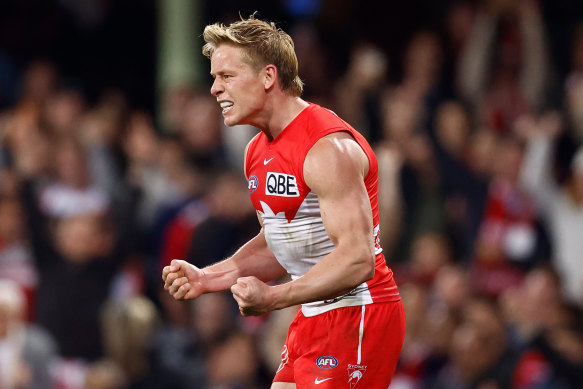
Isaac Heeney led the Swans to victory in spectacular style.Credit: AFL Photos
It has forever been the case, with Scott Pendlebury’s last quarter in the 2023 grand final separating two outstanding teams.
But the football truth stood out like a fluorescent pen in this round of comebacks the AFL could have termed the John Farnham round.
The statistics will show the depth of their influence, but their performances were also a reminder in the week Richmond’s big-game guru Dustin Martin announced his retirement that first-round picks are where these talisman types are generally found.
Heeney and Dangerfield (who is the bona fide champion among the trio) were rated higher in their draft than where they were eventually picked, with the Swans stealing their academy graduate with pick 18 after Melbourne made a bid at pick two. Adelaide grabbed Dangerfield as a 17-year-old at pick 10, a Matt Rendell special, despite him still being at school.
With Nick Daicos effectively out of the pool, North Melbourne secured Horne-Francis, of course, at pick No.1 (the belief on which of the two deserved to be first pick was evenly split among recruiters) before he went where he wanted, joining Port Adelaide at the end of his first season.
Martin, Pendlebury, Lance Franklin, Joel Selwood, Luke Hodge, Marcus Bontempelli and Christian Petracca were all found in the top 10 and regularly determined the fortunes of the clubs that nabbed them.
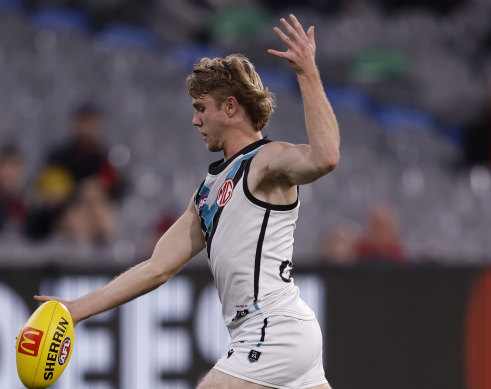
Jason Horne-Francis was exceptional at the MCG against the Demons.Credit: AFL Photos
Jordan De Goey’s decisive goal in last year’s grand final is exhibit A for this reality, with Pendlebury to Daicos to De Goey the clincher.
Harley Reid, Jamarra Ugle-Hagan, Izak Rankine, Aaron Cadman and Harry Sheezel promise to be the men for their team, while Daicos has already started being that man.
It’s why Essendon and St Kilda supporters tear their hair out – as Richmond supporters did a generation ago – at the failed moments at the draft table in the past decade that left them with less to enjoy than other fans.
Those two clubs have not made the most of their chances at the top end of the draft or the trade table when the opportunity has arisen, gaining good rather than any great players with top-10 picks, which is why any real success has eluded them for a decade.
It’s also why it’s so imperative the AFL levels the need to grow the game and tradition with competitive balance because even with the positive changes earmarked, the access to talent remains skewed, and therefore, the lengths clubs will go to for that talent will, at times, not reflect well on those chasing, as St Kilda found out this week.
Heeney, Dangerfield and the hyphenated heir’s will to win simply dragged their teammates over the line.
Heeney and Dangerfield won contests on the ground and in the air in a desperate last quarter. Perhaps Heeney could release a narrated video of his heroics this week, which included 14 disposals, a goal and four inside-50s in the last quarter. If he doesn’t get three Brownlow votes while known to be ineligible, the medal will be tarnished.
The Geelong skipper’s mark inside 50 in the early part of the last term carried an imperious air. He kicked a goal to end Geelong’s run of missed set shots and strutted around like an impatient rooster in a barnyard. He took two contested marks inside 50 and won six contested possessions in the final quarter.
Horne-Francis is a match winner. He is a Dangerfield clone at just 21, with pulled up socks and thighs the size of watermelons. He took six marks in the last quarter, won a free kick, pushed back to help and moved forward to worry Melbourne with 10 disposals.
The Blues are not only beaten up, they are beaten
Despite this column suggesting last week the Blues were still in the hunt, Sunday’s game contained two messages: Carlton are done, and hot shot Hawthorn are finals bound.
The knockout blow to the Blues’ season came when Charlie Curnow limped from the ground after his ankle collapsed and the round’s results made a compelling case that a wildcard round is not a good idea.
Hawthorn’s run and flair had already overwhelmed Carlton, but with Tom De Koning missing, Sam Walsh and Blake Acres obviously hurting, as well as injuries to Curnow, Adam Cerra, Jack Martin, Matthew Cottrell, Adam Saad and the season-ender to Sam Docherty, they have buckled. And they face a pre-season off Ikon Park as the turf is replaced.
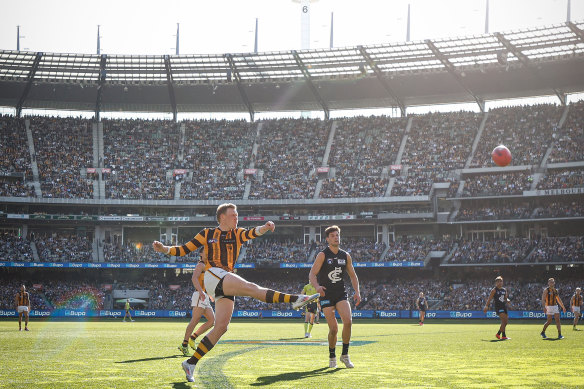
Hawthorn represented flair and dare while the Blues looked beaten at the MCG in round 22Credit: AFL Photos
Since round four, when Carlton were undefeated and the Hawks winless, the Blues’ win-loss record is 8-9 compared to 12-5 for the injury-free Hawks, with the losses to Port Adelaide and the Giants hard to believe given the commanding positions they were in late in those games. Those two losses are the only defeats Calsher Dear has experienced.
The Hawks are in the eight, and Carlton have joined the other big three in Collingwood, Essendon and Richmond outside the eight. The Blues are not repeating last year’s run. That’s Hawthorn’s job this year.
They wobbled but where to now for Collingwood?
The reigning premiers will not make finals after their pattern of not being able to defend leads finally cost them a match and a shot at finals even though other results fell their way over the weekend.
In their past three games Collingwood have been outscored 24-85 in the last quarters and even with some umpiring decisions that went against the Magpies late, a flaw has emerged.
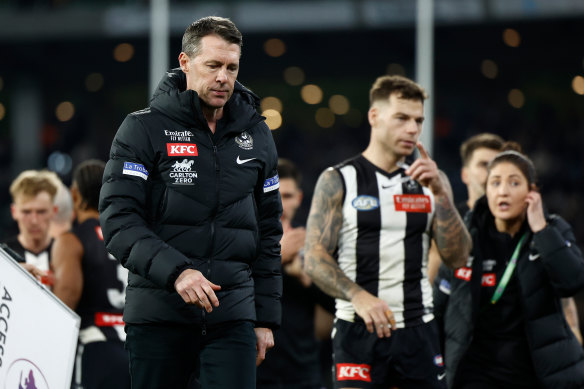
It’s been a return to reality for Craig McRae in 2024.Credit: AFL Photos
Perhaps it’s the lack of a big-bodied midfielder with Tom Mitchell absence filled by Lachie Sullivan and then Ned Long that has resulted in their midfield being overwhelmed late in games, as Patrick Cripps and then Heeney have done.
Perhaps their game style that demands constant running is challenging to maintain for four quarters late in a season that has tested the team’s depth with injuries after running deep into finals two seasons in a row.
With more on his plate this season, McRae has been more agitated and was not at his best post-match.
The questions now are who among the group of young players in the VFL is ready to emerge and what is their list strategy to re-emerge as a force, with Daicos’ presence meaning they will have plenty to build around.
Listening to the list management expertise and experience that have been at the club through their ups and downs is essential.
Mac Andrew’s career could haunt Melbourne supporters
As Melbourne trudged from the MCG knowing any hopes of redemption were over, the Demons’ Next Generation Academy graduate Mac Andrew was lining up to kick a match-winning goal after the siren just kilometres away at Marvel Stadium.
That’s because the Demons weren’t allowed to match a bid for him under short-lived NGA rules introduced after Ugle-Hagan joined the Bulldogs at pick one in 2020 that limited a club’s priority access to their graduates when Gold Coast used pick five in the 2021 national draft to call his name.
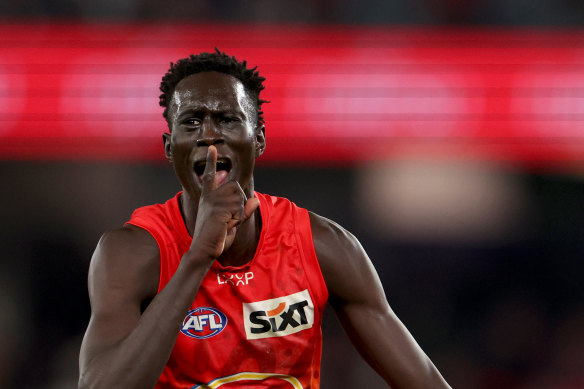
The goal after the siren was a brilliant moment for the Suns and Mac Andrew.Credit: Getty Images
Under the father-son rules left in place, the Bulldogs landed Sam Darcy with pick two and Collingwood grabbed Daicos at pick four before the Suns moved to get Andrew.
The Demons have kicked 16 goals in the past two rounds while Andrew has kicked seven himself for the Gold Coast in that time. They have also attracted fewer than 20,000 fans to their past two MCG clashes.
There is no way to sugarcoat it. The Demons were, like a few other clubs, dudded by the flip-flopping on rules that led to access limits from 2021-23.
Now, a more serious question needs to be answered on whether the NGA process is actually delivering on its well-intentioned objective to introduce new players to the game who would have otherwise chosen other sports or being merely a defacto academy exploited by clubs fortunate to find a talented player in their zone with an eligible background.
The AFL says it is reviewing eligibility rules. It should not shirk any issues in that process, or it will become a farce.
Of course, if the Demons had a chance to get Andrew, they would have needed a different strategy to collect late picks and would not have Jacob van Rooyen, Blake Howes and others on their list as a result.
But, as we pointed out, consistent match winners are found at the top of the draft.
Keep up to date with the best AFL coverage in the country. Sign up for the Real Footy newsletter.